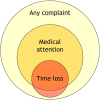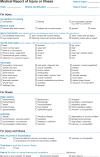International Olympic Committee Consensus Statement: Methods for Recording and Reporting of Epidemiological Data on Injury and Illness in Sports 2020 (Including the STROBE Extension for Sports Injury and Illness Surveillance (STROBE-SIIS))
- PMID: 32118084
- PMCID: PMC7029549
- DOI: 10.1177/2325967120902908
International Olympic Committee Consensus Statement: Methods for Recording and Reporting of Epidemiological Data on Injury and Illness in Sports 2020 (Including the STROBE Extension for Sports Injury and Illness Surveillance (STROBE-SIIS))
Erratum in
-
Corrigendum to "International Olympic Committee Consensus Statement: Methods for Recording and Reporting of Epidemiological Data on Injury and Illness in Sports 2020 (Including the STROBE Extension for Sports Injury and Illness Surveillance (STROBE-SIIS))".Orthop J Sports Med. 2020 Dec 28;8(12):2325967120984266. doi: 10.1177/2325967120984266. eCollection 2020 Dec. Orthop J Sports Med. 2020. PMID: 33447625 Free PMC article.
Abstract
Background: Injury and illness surveillance, and epidemiological studies, are fundamental elements of concerted efforts to protect the health of the athlete. To encourage consistency in the definitions and methodology used, and to enable data across studies to be compared, research groups have published 11 sport- or setting-specific consensus statements on sports injury (and, eventually, illnesses) epidemiology to date.
Objective: To further strengthen consistency in data collection, injury definitions, and research reporting through an updated set of recommendations for sports injury and illness studies, including a new Strengthening the Reporting of Observational Studies in Epidemiology (STROBE) checklist extension.
Study design: Consensus statement of the International Olympic Committee (IOC).
Methods: The IOC invited a working group of international experts to review relevant literature and provide recommendations. The procedure included an open online survey, several stages of text drafting and consultation by working groups, and a 3-day consensus meeting in October 2019.
Results: This statement includes recommendations for data collection and research reporting covering key components: defining and classifying health problems, severity of health problems, capturing and reporting athlete exposure, expressing risk, burden of health problems, study population characteristics, and data collection methods. Based on these, we also developed a new reporting guideline as a STROBE extension-the STROBE Sports Injury and Illness Surveillance (STROBE-SIIS).
Conclusion: The IOC encourages ongoing in- and out-of-competition surveillance programs and studies to describe injury and illness trends and patterns, understand their causes, and develop measures to protect the health of the athlete. The implementation of the methods outlined in this statement will advance consistency in data collection and research reporting.
Keywords: STROBE; epidemiologic methods; illness; injuries; surveillance.
© The Author(s) 2020.
Conflict of interest statement
One or more of the authors has declared the following potential conflict of interest or source of funding: B.R. receives payment for duties as Editor-in-Chief of The Orthopaedic Journal of Sports Medicine. AOSSM checks author disclosures against the Open Payments Database (OPD). AOSSM has not conducted an independent investigation on the OPD and disclaims any liability or responsibility relating thereto.
Figures









References
-
- Ahmad CS, Dick RW, Snell E, et al. Major and Minor League Baseball hamstring injuries: epidemiologic findings from the Major League Baseball Injury Surveillance System. Am J Sports Med. 2014;42(6):1464–1470. - PubMed
-
- American Spinal Injury Association. International Standards for Neurological Classification of Spinal Injury. Chicago: American Spinal Injury Association; 2019.
-
- Bahr R. No injuries, but plenty of pain? On the methodology for recording overuse symptoms in sports. Br J Sports Med. 2009;43(13):966–972. - PubMed
-
- Bahr R, Clarsen B, Ekstrand J. Why we should focus on the burden of injuries and illnesses, not just their incidence. Br J Sports Med. 2018;52(16):1018–1021. - PubMed
LinkOut - more resources
Full Text Sources

